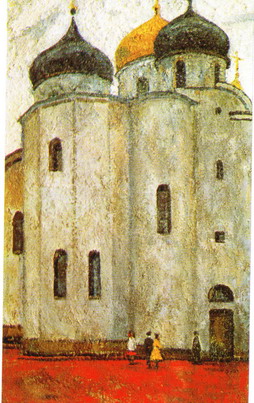Early Russia’s foremost cultural and art centre, Novgorod was first mentioned in a scripture in 859. For the many centuries ever since Novgorod produced a large artistic school and preserved numberless monuments of the 11th-17th-century architecture, along with artistically outstanding works of early monumental painting. Novgorod remained unconquered throughout the hard times of Tartar invasion, so that its cultural monuments and artistic traditions survived until to-day. This explains the city’s special significance in Russian art.
Grandeur and huge dimensions are typical of the architecture of the princely period, its greatest achievements being the most ancient structure in Northern Russia, St Sophia of Novgorod (1045-1052), the city’s principal cathedral, as well as the Cathedral of St Nicholas on the Yaroslavovo Dvo-rische [Stead] (1113), the Cathedral of the Nativity of the Virgin (1117) in the Antoniev Monastery and the Cathedral of St George in the Knyazhy Yuriev Monastery (1119); they are perfectly characteristic examples of the early Novgorod School in architecture.
Since the dawn of the 12th century and up to 1478 in which year it joined Moscow, Novgorod remained a Vetche Medieval Republic (governed by popular assembly), its architecture unusually rich in outstanding architectural monuments. Although less representative in their design of the
Novgorod style, the cathedrals of St Nicholas on the Lipna (1292), of the Dormition on the Volotovo Field (1352), of the Nativity in the Perynsky Hermitage (late 12th-early 13th century) marked the milestones of progress in creative architectural thinking of those architects whose credo, expressive and magnificent, was made clear in these works.
Full of intimacy and a special charm, these monuments constituted a significant stage in the shaping out of the classical Novgorod temple style dating back to the period of blossoming of architecture in the Vetche Novgorod Republic. The Cathedral of St Theodore Stratilates-on-Ruchei, an earlier but perfect example of this temple style, was an embodiment of the achievements of earlier Novgorod architects and a model for many later temples, each of them showing some individual architectural characteristics. Of the latter cathedrals the Cathedral of the Transfiguration on Ilyina Street (1374), with its unique frescoes executed by Theophanes the Greek, stands out for the fine decor of its facades.
The Novgorod period in art, with its monumental architecture and 11th-16th-century painting, was an important development in All-European culture, whose national idiom was dazzling, and the imagery superb in terms of being laconic, expressive and artistically complete.



